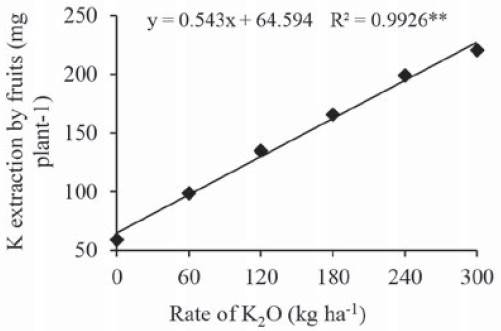Introduction
Strawberry (Fragaria χ ananassa (Duchesne ex Weston) Duchesne ex Rozier.) is an important crop of economic relevance in Brazil. Among the small fruit is one of the most important, due to its use versatility use and marketing (fresh and processing), high profits to growers and is widely known and accepted by consumers (Santos, Fernandes, Melo, Sobral, Brito, Dantas & Bonfim, 2009) .
In the last years, Brazilian strawberry production had achieved an increasing. In 2013, estimate strawberry production was 110 thousand tons, in a cultivated area of 4200 hectares, emphasizing the states of Minas Gerais, Paraná, São Paulo and Rio Grande do Sul (Passos, Trani, & Carvalho, 2015). The expansion of cultivated area is associated mainly to advances in research and technology related to strawberry crop likewise an increasing in fruit consumption.
Strawberry physiology is influenced by abiotic factors as follows: mineral nutrients, water, electricity, CO2, temperature and photoperiod. Mineral nutrients are noted for acting directly on plant metabolism as ions, molecules or incorporated into cellular structures, which is essential to life cycle (Marschner, 2012). In this sense, knowledge about nutrients requirement to strawberry crop enables the maintenance of a satisfactory yield and fruit quality (Tagliavini, Baldi, Lucchi, Antonelli, Sorrenti, Baruzzi & Faedi, 2005).
It is known that potassium (K) is one of the most exported nutrients by strawberry and also exerts great influence on yield and fruit quality (Kaya, Kirnak, Higgs & Saltali, 2002). In fact, K deficiency decreases fruit yield and quality, due to a decreasing in internodes size, in apical dominance and in plant growth, delaying filling fruit and producing smaller fruits and lower color intensity (Passos, Trani & Carvalho, 2015). Therefore, nutrient excess can cause unbalance in calcium (Ca) and magnesium (Mg) levels, or even, burning the old leaves edges and the apex (Marschner, 2012).
Some studies with different fruits and vegetables have shown that the use of high doses of K fertilizers results in higher yield and average fruit mass, besides improving the physical and chemical characteristics as soluble solids, ascorbic acid, color and firmness (Costa, Cecílio, Cavarianni & Barbosa, 2004; Trevisan, Herter, Coutinho, Gonçalves, Silveira & Freire, 2006; Marodin, Resende, Morales, Camargo, Camargo & Pavinato, 2010) . However, in strawberry, the influence of K fertilization on fruit quality and yield has been little studied, as well as the comparison among sources of this nutrient and exportation through fruits in order to develop management strategies that optimize fertilizer use efficiency and avoid the application of doses above required.
Given these concerns, the aim of this study was to evaluate the plant development in terms of yield and nutrition of greenhouse-grown strawberries (Fragaria χ ananassa (Duchesne ex Weston) Duchesne ex Rozier. cv. Camarosa) as affected by different sources and doses of potassium fertilization.
Material and methods
An experiment was carried in a greenhouse, using 2.5 dm3 plastic pots filled with an oxisol soil between June and November 2010 in Guarapuava, Paraná state (25°23'36 "S, 51°27'19 יי W, 1050 m.a.s.l.).
A soil sample of 20cm depth was used to chemical analysis whose showed the following results: pH (CaCl2) = 5.1; SOM.= 34.9 g dm-3; P (Mehlich) = 0.7 mg dm-3; K = 0.06 cmol dm-3; Ca = 0.3 cmol dm-3; Mg = 0.3 cmol dm-3; H °+ Al = 3.01 cmolc dm-3; SB = 0.73 cmolc dur3; CTC (pH 7) = 3.67.
An experimental design was performed with a factorial arrangement for three K fertilizer sources and six rates from each fertilizer with four replicates. Each replication was composed by the average data of two plastic pots in order to improve the normal results distribution. Sources utilized were potassium sulfate (K2SO4), potassium chloride (KCl) and potassium nitrate (KNO3). Fertilizer rates were as follows: 0; 60; 120; 180; 240 e 300 kg ha-1 of K2O (0; 0.23; 0.46; 0.69; 0.92 and 1.15 g of K2O.plant-1). K fertilizer rates were applied as a nutritive solution and parceled in three times: at 10, 60 and 120 dat (days after transplanting).
Basis saturation was enhanced to 80% with the application of slaked lime (Ca(OH)2). Therefore, was added Ca in form of gypsum (8 g plant-1); Mg in form of magnesium carbonate (MgCO3) (850 mg plant-1); P in form of triple super phosphate at rate of 3 g. plant-1 at planting and 3 g. plant-1 side dressed 140 dat; and N at planting, in form of urea (NH4NO3) diluted in water at rate of 50 mg of pot-1 (22 mg N. plant-1).
As a complement to fertilization, was added Ca and B as foliar application six times in form of CaB 105® (Ca 10% and B 0.5% - concentration of 0.15% and rate of 0.013 ml.plant -1)
Each pot received a strawberry runner of cultivar Camarosa, from Chile, selected according to crown diameter (10 to 12 mm) and root length (approximately 12 cm). Irrigation was performed through drip system, scheduled according to weather and plant growth stage. Phytosanitary control was performed by spraying specific and registered products to strawberry crop in the state of Parana, Brazil.
Strawberry was harvested for 13 weeks; fruit were picked when the surface was at least 75% dark red. We analyzed the plant yield (g.plant-1), number of fruits per plant, average fruit weight (g), K leaf concentration (g kg-1 of DM), K fruit concentration (g kg 1 of DM) and K extraction through fruits. K leaf concentration analysis using the 3rd and 4th newly developed composed leaves, without petiole, from each pot, in a total of four leaves to each treatment. Leaves sampling was at 140 dat, at the end of crop cycle, not at the flowering stage, as indicated by authors. Samples were dried to constant weight in a forced air circulation oven at 65°C and grinded at a "Willey' mill. K determination brought out results in g kg-1 of leaves dry matter. The K extraction through fruits was calculated with the sum of extractions for all harvests. It was calculated by multiplying K fruit concentration with its dry matter (DM) from each harvest. This way, obtained the extraction from each harvest.
Results were submitted to normality test and homogeneity of variance. Subsequently, to the analysis of variance by F test with 5% of probability. Average results for "K fertilizer sources" factor, were compared by Tukey's test (p<0.05) and results for "K fertilizer rate", were adjusted through polynomial regression method. To evaluate the association degree among traits, were estimated Pearson's correlation coefficients with significance levels obtained by t-test.
Results
There was no interaction among the factors K fertilizer sources and rates for the evaluated variables. K concentration in fruit and leaves, plant yield, number of fruits per plant, average fruit weight and K extraction by fruits, were influenced by the fertilizer rates. K concentration in strawberry leaves was the only variable affected by K fertilizer sources (Table 1).
Table 1 Analysis of variance to: yield of fruits per plant (Yield), number of fruits per plant (N° fruit.), fruits average weight (Fruit weight), content of leaf K (leaf K), content of fruit K (Fruit K), extraction of K by fruits in mg of k plant-1 (K fruit extrac.).
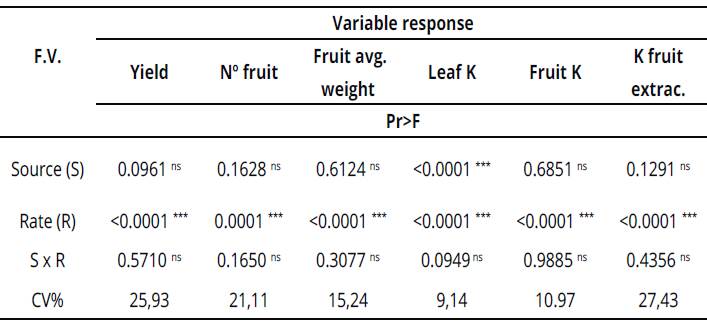
ns not significant; *** significant at less than 0.1% of error probability by F test.
A highest K leaf concentration was obtained with potassium nitrate (KNO3), 11.70 g kg-1 of DM, followed by 10.95 g kg-1 of DM with potassium chloride (KCl) and 10.07 g kg-1 with potassium sulfate (K2SO4) (Table 2).
Table 2 Percent of leaf K and in the fruits of strawberry cv. "Camarosa" in response to sources of potassium fertilizers.
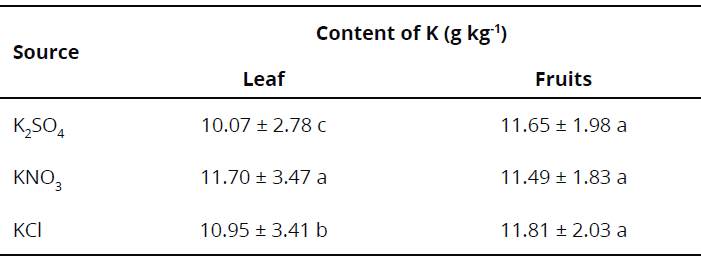
Means followed by the same letter in the column do not differ significantly, according to Tukey's test p<0.05.
K foliar concentration had achieved an increasing according to fertilizer rates (Figure 1).
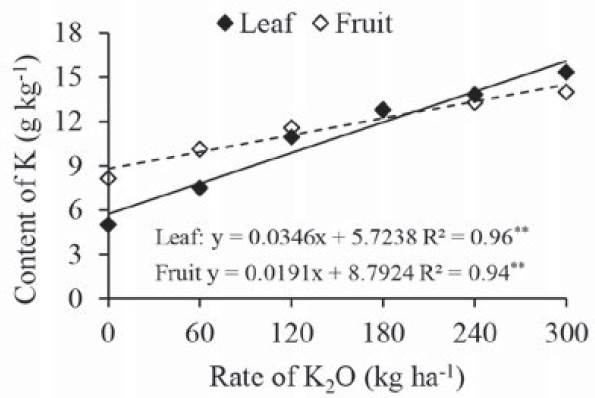
Figure 1 Leaf potassium content and fruit potassium content in strawberry cv. Camarosa (g kg-1). "Significant to1%of probability.
There was no difference of K fruit concentration between the fertilizers source and the average value was 11.65 g kg-1 of DM. In relation to fertilizers rates, there was a linear increasing in K fruit concentration according to an increasing fertilization rate (Figure 1), likewise observed for K leaves concentration.
Average fruit production per plants was 260.8 g and there was no difference among K fertilizers sources. In relation to K rates, we observed a greater fruit production when was applied a greater rate of K fertilizer (Figure 2) independent of the origin source.
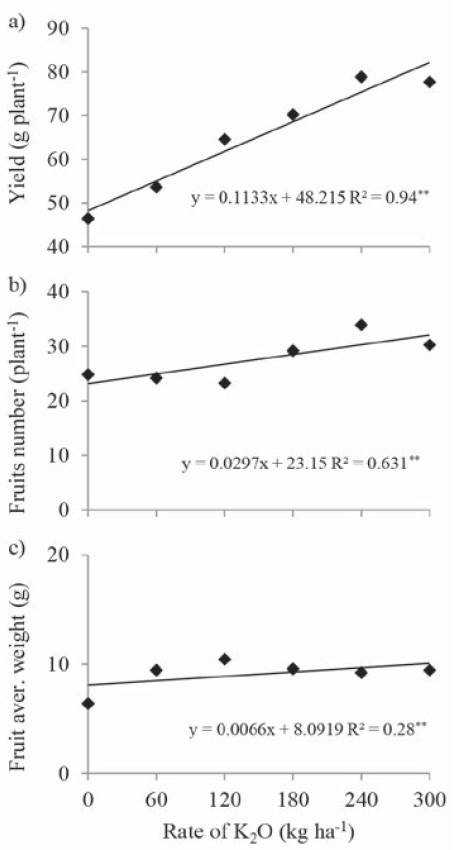
Figure 2 (a)Yield per plant (g plant-1), b) fruit number per plant, c) average fruit weight (g) in strawberry cv. Camarosa in response to rates of K2O (kg ha-1). "Significant to1%of probability.
In this sense, with a rate of 300 kg K2O ha-1 was obtained 310.7 g plant-1. This yield was around 40% bigger than that obtained without K fertilizer. These results confirm the inference that plants respond to K fertilization when soils have low levels of this nutrient, as observed at the soil utilized for this study.
Due to the application of 2 g of SO4 plant-1 or 1 g of sulfur (S) plant-1 in the source of gypsum at experiment implementation, there was no effect of the S supplied by K2SO4. As we observed with N, S content was not crucial to a higher yield because there was no interaction between sources and rates.
Average fruit weight (g) values according to K2O rates were suited to the quadratic model, where the estimated rate of 183 mg kg-1 resulted a higher value to this variable (10.18 g), independent of the K fertilizer source used (Figure 2). To the different sources, the average values did not differ and the values obtained were 9.27 g; 9.10 g; and 8.87 g, to K2SO4, KNO3 and KCl, respectively.
K fruit concentration positively correlated with K leaf concentration (r = 0.99) (Table 3). Owing to its high K content in leaves, which stimulated an increasing in K content in strawberry fruits.
Table 3 Summary of correlations among measured variables.
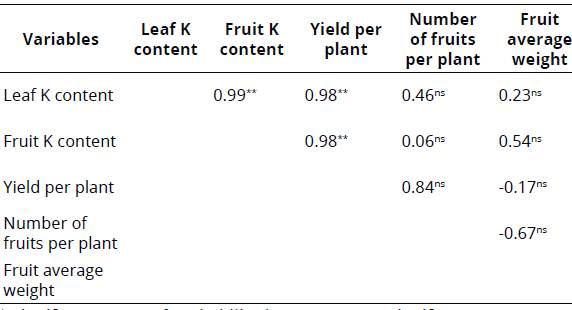
** Significant at 1% of probability by t test; ns not significant.
There was a linear increasing in the number of strawberry fruits per plant according to an increasing in K fertilizer. The same effect was observed to fruit yield (Figure 3).
Discussion
It was observed a greater supplying of nitrogen (N) available to plants fertilized with KNO3 than those fertilized with KCl and K2SO4 probably, explain these results. According to Primavesi, Primavesi, Corrêa, Silva & Cantarella (2006), fertilization with K increases N use efficiency, since K is essential for protein synthesis, stomatal oppening and enzyme activation (Marschner, 2012). Due to a greater amount of N available to the synthesis of nitrogen compounds, probably, there was a greater demand of K to participate in these process.
At the treatment without K fertilization, the concentration was 5 g kg-1 of DM, while at rate of 300 kg K2O ha-1 was 15.35 g kg-1 of DM. However, even at the greater rate (300 kg K2O ha-1), K concentrations were lower than those considered adequate for strawberry crop (Andriolo, Jânisch, Schmitt, Dal Picio, Cardoso & Erpen, 2010). These authors found that K content in leaves collected at beginning of the flowering stage, conversely, in this study, were collected at the end of the crop cycle. At the end of crop cycle, K translocation from leaves to fruits may have been greater, which could explain a lower concentration of this nutrient in this study.
When was applied 300 kg K2O ha-1, average K fruit concentration was 14 g kg-1 of DM, while without fertilization the average concentration was 8.14 g kg-1 of DM.
Rocha, Abreu, Corrêa, Santos & Fonseca (2008), observed concentrations of 8.7, 8.4 e 7.6 g of K kg-1 of DM, respectively. However, in that research they did not used different fertilizer rates and results obtained match to the observed without fertilization, which confirms what we obtained: K fruit concentration increases with application of greater rates of K fertilizer.
These results are comparable in variability to the report by Quaggio, Mattos & Boaretto (2011), who observed that Valência oranges production had achieved an increasing yield according to the K fertilizer rates. This effect was attributed to low level of K in soil. In addition, authors verified that there was no effect of K sources utilized (KCl and K2SO4) in fruit production. Other studies also confirmed an increasing in fruit production for banana cv. prata anã (Santos et al., 2009), in apple 'Fuji' (Ernani, Dias & Flore, 2002) with increasing rates of K fertilizer.
Certainly, one of the K positive effects is an increasing in fruit number per plant. Costa, Cecí lio, Cavarianni & Barbosa (2004), verified a linear addition of melon fruit set with an increasing of K concentration at nutritive solution. Conversely, Andriolo, Jânisch, Schmitt, Dal Picio, Cardoso & Erpen (2010), verified in a strawberry grow ing soilless, lower number of fruits per plant at biggest rate of K fertilizer with KNO3 and mono potassium phosphate (KH2PO4). In this case, the authors explain that high doses of K may have induced deficiencies of calcium and magnesium by competitive absorption among these nutrients, leading to a decreasing production and reduced fruit number per plant. In our study, possibly, there was not a competitive relation among these nutrients because even the highest rates of K did not affect the strawberry yield and fruit number per plant.
An increasing in fruit number per plant ac cording to K fertilization, could be related to the reduction of drop fruits because of the peduncles become more resistant. Furthermore, the addition of K to plants results in an increasing of photo-assimilated compounds and, consequently, a bigger mobilization of foliar N in the syntheses of macromolecules that are used in plant growth and in fruit production (Marschner, 2012).
Number of fruits per plant did not differ ac cording to the fertilizer sources and the average result, which was 27.6. Therefore, the element that was supplied with K in the three sources did not interfered this result. N from KNO3 did not interfered the yield due to the application of 22 mg of N.plant-1 during the experiment implementation. That application supplied the amount of N necessary to strawberry crop. Even N content from different rates of KNO3, did not contribute to an increasing in fruit yield, which was confirmed by the lack of interaction between sources and rates.
Therefore, average fruit weight was not affect ed linearly by an increasing in K fertilization as observed with yield and fruit number per plant. It demonstrates that in greater K rates, there is a greater production of smaller fruits, not desirable to in nature trade. According to Kaya, Kirnak, Higgs & Saltali (2002), K rates much greater than the recommended, promote reduction in fruit size and yield of strawberry.
An increasing of average fruit weight through K fertilization, can be attributed to important role of potassium plays in photo-assimilated translocation of leaves to fruits and its role in cell extension (Marschner, 2012).
Similar to our research but without evaluat ing K fertilization, Radin, Lisboa, Witter, Barni, Reisser, Matzenauer & Fermino (2011), observed the average fruit weight of 11.8 g and 12.6 g to "Camarosa" cultivar. In other studies carried out with this cultivar, were found values of fruit weight, which ranged from 12.79g to 41.53g (Oliveira & Scivittaro, 2009; Oliveira & Scivittaro, 2009; Antunes, Ristow, Krolow, Carpenedo & Reisser, 2010; Resende, Morales, Faria, Rissini, Camargo & Camargo, 2010).
K rates influenced significantly the extraction of this nutrient by fruits, while the sources and the interaction among these factors did not in fluence. K extraction at treatments with different sources was in average, 146.1 mg of K plant-1. Related to K rates, we verified that K extraction linearly had achieved an increasing in the form of K2O rates (Figure 3), variating from 58.4 (without K) to 220.3 mg of K plant-1 (K rate of 300 kg.ha-1).
In this study, the greatest extraction value was approximately 220.3 mg K plant-1, found at rate of 300 kg ha-1 of K2O. This difference can be explained by fruit yield, since we obtained a smaller yield in our study; selected cultivar; crop management and interactions between nutrients in soil and plant (Marschner, 2012).
We also observed a positively correlation between K content in leaves and fruit yield (r = 0.98); and K fruit concentration and yield (r=0.98) (Table 3). K is related to plant photosynthesis because it promotes protein synthesis and activates the necessary enzymes for its operation, regulates the opening and closing of stomata, participates in starch synthesis and participates in the trans location and storage of photo-assimilated (Kaya, Kirnak, Higgs & Saltali, 2002).
Bearing this in mind, potassium supplying increases the plant development and, as consequence, there is an increasing in fruit yield.
Conclusion
A supplying of K by any fertilizer sources provided a greater K concentration and also a greater extraction of this nutrient in strawberry fruits cv. Camarosa. Given these concerns, an increasing in K rate provided an increasing in fruit yield and fruit number per plant. However, after 183 kg ha-1 of K2O, there is a decreasing in the average fruit weight, which does not justify the utilization of greater rates when the aim is fruit yield in nature trades.













